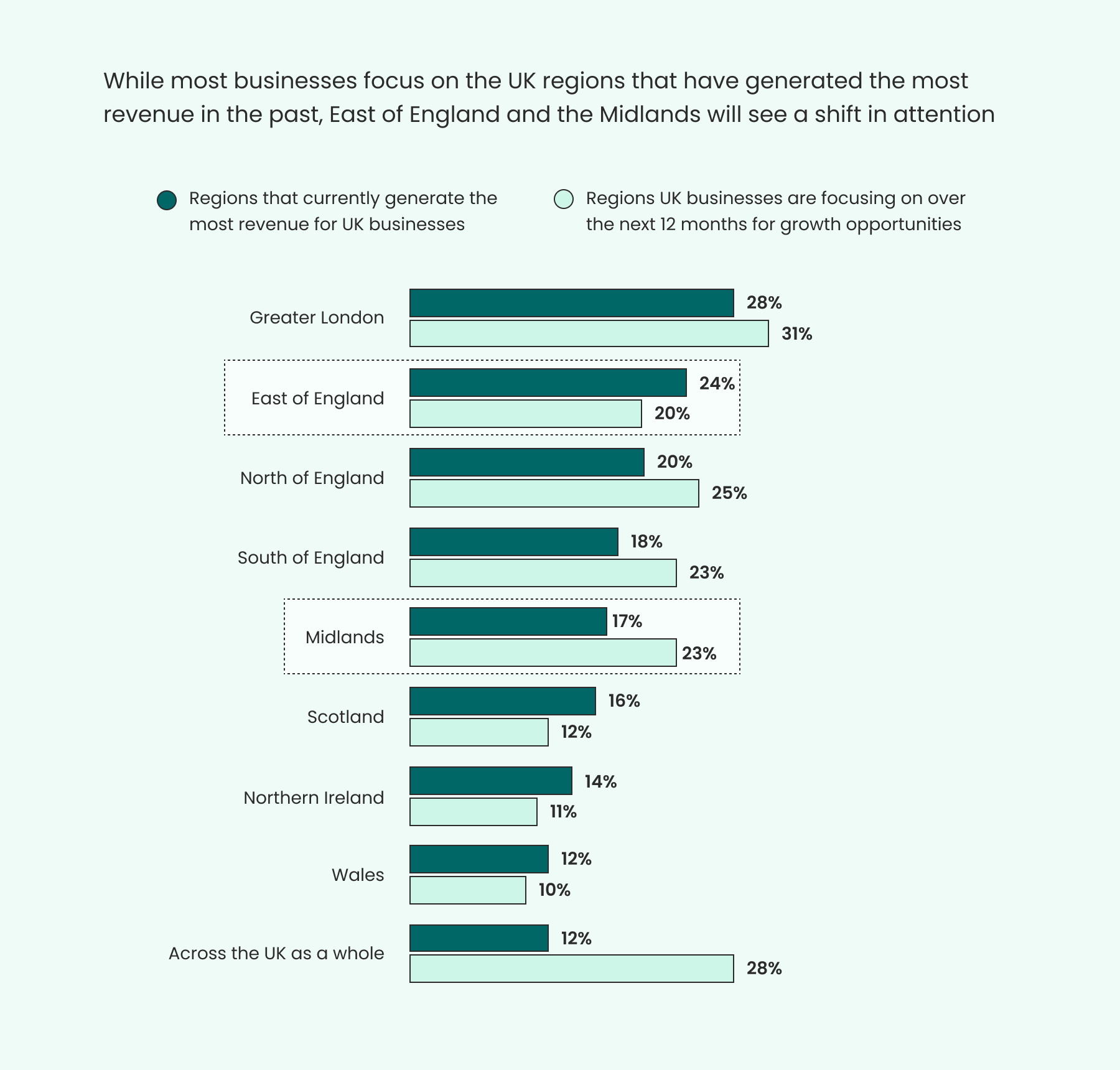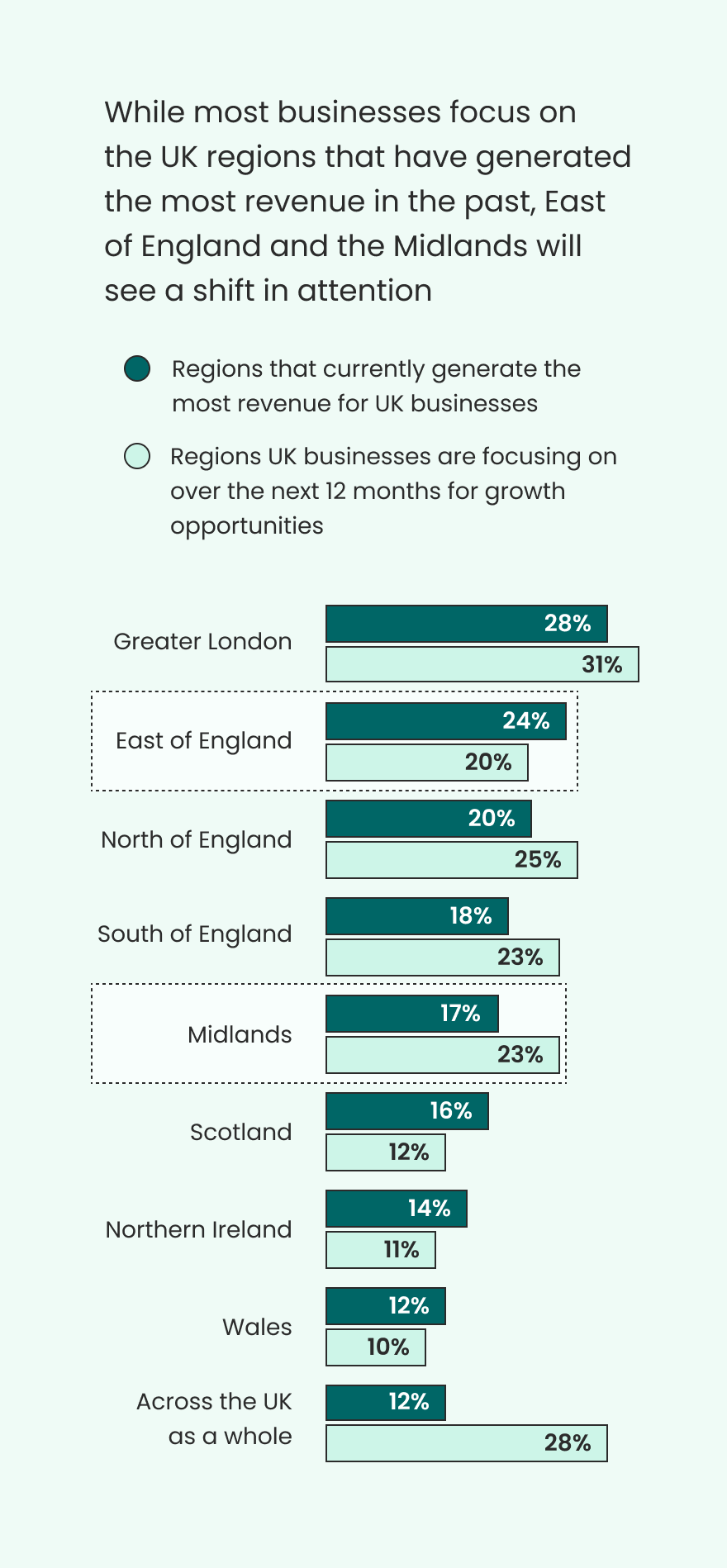Moving the dial: finding success when evolving regional approaches
New research by Barclays Corporate Banking finds that to optimise performance and productivity, businesses must be resourceful. But how?
Featured Regions:
Midlands, East of England, North England
Moving the dial
Despite today’s challenging economic conditions, many businesses are confidently looking to expand into new parts of the UK, according to a new survey by Barclays Corporate Banking. But as businesses evolve their regional strategies, how can leaders be sure they are placing their attention and resource in the right areas?

A clear analysis of market dynamics is key for companies to ensure that their sales, customer service and R&D teams focus on the areas that hold the most revenue potential. In fact, 72 per cent of respondents say their company is very effective at ensuring all regions of interest receive adequate attention.

A man walking his dog through an oilseed rape field, United Kingdom
GETTY IMAGES
Signals to consider when assessing regional strategies
One of the most important considerations is timing. When should businesses mobilise their resources to increase efforts in a certain UK region? Is it time to free up capacity by dialling down ineffective use of resource in other UK regions?
Part of answering these questions involves evaluating the business’s readiness. Where revenue growth has plateaued in a certain region, rather than immediately focusing attention elsewhere, there may be an opportunity to try different tactics that may unlock a fresh growth spurt. Deep dives into customer, employee and partner feedback could reveal areas of opportunity to strengthen competitive edge in a region. While a new approach is being formulated, resource could be used to implement strategy in new territories, including reassigning personnel with transferrable skills to the new markets of focus. Plans should also consider whether existing suppliers and distributors can evolve with the business as it explores new regions.
Businesses also need to pay close attention to external market signals. That could include existing customers asking about initiatives in new regions or a rise in enquiries from prospects based in those markets. These are strong indicators that the company’s brand has potential to expand into these new territories.

New Street Grand Central Station, Birmingham, United Kingdom
Adobe Stock
Identifying "where client requirements are most abundant” is guiding multi-disciplinary property consultancy Fisher German on how to best allocate its resources across its network of 27 UK offices, says managing partner Andrew Bridge.
“For example, we are looking to focus more of our resources towards Birmingham where we are soon to open a new office in the city centre,” says Bridge. “With its highly accessible location for both staff and clients, and the huge potential in the Midlands market, it reinforces our commitment to what our clients are seeking from a multi-disciplined consultancy.”
With its highly accessible location for both staff and clients, and the huge potential in the Midlands market, it reinforces our commitment to what our clients are seeking from a multi-disciplined consultancy.
Andrew Bridge, Managing Partner at Fisher German
Listening to market signals may give leaders a hunch that the time is right to roll out an update to regional strategies – but to fully commit, businesses will need a clear picture of where best to put their resources, by potentially drawing on multiple tools. According to our survey, the most commonly used inputs are market research (used by 42 per cent of the companies surveyed), industry trend analysis (36 per cent), competitor analysis and financial modelling (both 33 per cent), and partner and customer feedback (32 per cent). Executives also prefer to draw on specialist expertise: on average, 87 per cent of respondents say they obtain external support for identifying new regional opportunities, with key partners including market researchers, data analytics firms and banks or financial advisers.
Those inputs can help inform key decisions about regional focus: will the goal be a balance or a decisive tilt towards a certain UK region? It is essential to assess potential risks – such as dissatisfaction among existing customers if they feel downgraded – versus the upsides of seizing new opportunities.
Executives should be prepared to keep these plans under constant review. Building an effective regional strategy is a fluid, ongoing process and businesses must be ready to pivot quickly as the situation demands.
Identifying the UK’s growth hotspots
The research also sheds light on how businesses are evaluating the opportunities to be found across the UK, as they consider where to focus their efforts over the next 12 months.
The data suggests that businesses’ attention is gravitating towards the regions where they have generated most revenue in the past. Greater London tops the table and is identified as the primary focus by 31 per cent of businesses surveyed.


There are exceptions, however. Only 17 per cent of businesses surveyed currently generate the majority of their income in the Midlands – but 23 per cent now focus on the region to drive growth. It is the only UK region to enjoy such a heightened focus. “The Midlands is already the largest regional economy outside London, and these results suggest that businesses recognise the potential for growth if they dial up their presence in the region,” says Karen Thomas, head of mid corporate Midlands at Barclays Corporate Banking.
The Midlands is already the largest regional economy outside London, and these results suggest that businesses recognise the potential for growth if they dial up their presence in the region.
Karen Thomas, Head of Mid Corporate Midlands at Barclays Corporate Banking
By contrast, the East of England is ranked second outside London for current revenue generation but drops to fifth in terms of prioritization for new growth. In response to this Stephen Ainsworth, head of mid corporate east at Barclays Corporate Banking, says: “Rather than a sign of limited interest, this may simply reflect businesses’ already strong footprints in this regional economy.” In fact, companies registered in the East of England are more likely than most to be looking outside the region for growth, with the biggest proportion focusing on Greater London (50 per cent) and as many focusing on the North of England as on their home region (29 per cent).
As with any new venture, executives need a clear plan before shifting regional strategies and resources. But when they do have a clear plan – with robust evidence of the market opportunity and a financial and operational strategy – executives can move ahead confidently and swiftly to seize the opportunities for growth.
The information contained and views expressed in this article are intended purely for information and interest purposes only and no warranty or undertaking regarding the accuracy or completeness of the information of views is given. They should not be used to make any decisions or take any actions.







